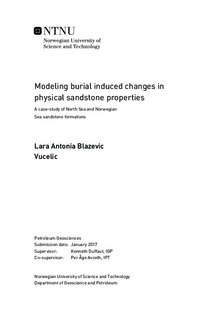| dc.description.abstract | The changes in physical properties of sandstones with burial depth are a result of mechanical and chemical compaction processes. These processes are affected by rock microstructure, pressure regimes and temperature history. Data from 30 wells have been used to investigate and compare the changes in porosity, bulk density, elastic moduli and wave propagation velocities between the mid-Jurassic sandstones of the Etive Fm. in the North Sea and the Garn Fm. in the Norwegian Sea.
At shallow burial depths (less than 2 km) the changes of the physical properties are governed by effective stress. A mechanical compaction model is used to describe the porosity loss and the bulk density increase with depth, whereas the friable-sand theory is used to explain the changes in elastic moduli and wave propagation velocities. For both formations, the under predictions by the models in the porosity, bulk moduli and P-wave velocity values from the data suggest high depositional porosities (0.40) and small amounts of quartz cement at depths of 1.6-2.0 km.
At greater burial depths and temperatures (greater than 2 km, and greater than 75°C) quartz cementation is the main controlling factor in the changes of the physical properties. The porosity loss and the bulk density increase with depth are explained by means of a quartz cement precipitation model, and the contact-cement theory is used to describe the changes in elastic moduli and wave propagation velocities. High porosities (greater than 0.15) at great burial depths (greater than 4 km) suggest the presence of higher amounts of clay coatings in both formations, and they may also be a result of high overpressures. The great variations in porosity and bulk modulus values for Garn sandstones encountered at same depths, indicate that the Garn Fm. is less well sorted and more affected by different types of quartz deposition than the Etive Fm. The contact-cement model main over prediction trend for the bulk modulus of highly overpressured sandstones enlightens the effects of different pressure regimes in the chemical compaction domain. | |

